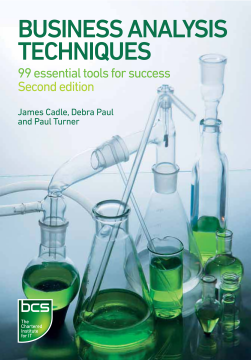
Additional Information
Book Details
Abstract
The development of business analysis as a professional discipline has extended the role of the business analyst who now needs the widest possible array of tools and the skills and knowledge to be able to use each when and where it is needed. This new edition provides 99 possible techniques and practical guidance on how and when to apply them. It complements Business Analysis also published by BCS, and offers a more detailed description of the techniques used in business analysis, together with practical advice on their application.
James Cadle has been involved in business systems for 35 years, in the public and private sectors, and is now a director of Assist Knowledge Development. Debra Paul is Managing Director of Assist Knowledge Development and was a founding member of the BA Manager Forum. Paul Turner is a director of Business and IS Skills and of Assist Knowledge Development, specialising in the provision of training and consultancy.
This book should be essential reading for all business analysts. Even after 30 years working in this field, I find it an immensely valuable reference. Excellent!
Dr Terri Lydiard
An excellent compendium of BA techniques packed with useful examples. BAs at all levels will discover something new.
Christina Lovelock
The role of the business analyst is to formulate options for a way forward and produce business cases setting out conclusions and recommendations. This professional discipline requires the widest possible array of tools and the ability to use each when and where it is needed. The new edition provides 99 possible techniques and applies them within a framework of stages. It complements Business Analysis (ed Debra Paul, Donald Yeates and James Cadle), also published by BCS, and offers a more detailed description of the techniques used in business analysis, together with practical advice on their application. This book will be of enormous benefit to business analysts, managers and to students of information systems and business strategy.
Table of Contents
| Section Title | Page | Action | Price |
|---|---|---|---|
| Cover | Cover | ||
| Copyright | iv | ||
| CONTENTS | v | ||
| LIST OF FIGURES AND TABLES | vii | ||
| AUTHORS | x | ||
| LIST OF ABBREVIATIONS | xi | ||
| ALPHABETICAL LIST OF TECHNIQUES | xiii | ||
| PREFACE | xviii | ||
| 1 BUSINESS STRATEGY AND OBJECTIVES | 1 | ||
| INTRODUCTION | 1 | ||
| STRATEGY ANALYSIS – EXTERNAL BUSINESS ENVIRONMENT | 3 | ||
| STRATEGY ANALYSIS – INTERNAL CAPABILITY | 9 | ||
| STRATEGY DEFINITION | 14 | ||
| STRATEGY IMPLEMENTATION | 17 | ||
| PERFORMANCE MEASUREMENT | 30 | ||
| REFERENCES | 33 | ||
| FURTHER READING | 33 | ||
| 2 INVESTIGATE SITUATION | 34 | ||
| INTRODUCTION | 34 | ||
| QUALITATIVE INVESTIGATION | 35 | ||
| QUANTITATIVE INVESTIGATION | 59 | ||
| DOCUMENTING THE RESULTS | 70 | ||
| REFERENCES | 77 | ||
| FURTHER READING | 78 | ||
| 3 CONSIDER PERSPECTIVES | 79 | ||
| INTRODUCTION | 79 | ||
| STAKEHOLDER IDENTIFICATION | 81 | ||
| STAKEHOLDER ANALYSIS | 84 | ||
| STAKEHOLDER MANAGEMENT | 108 | ||
| REFERENCES | 116 | ||
| FURTHER READING | 117 | ||
| 4 ANALYSE NEEDS | 118 | ||
| INTRODUCTION | 118 | ||
| ORGANISATION MODELLING | 119 | ||
| BUSINESS PROCESS ANALYSIS | 127 | ||
| BUSINESS CHANGE IDENTIFICATION | 152 | ||
| REFERENCES | 158 | ||
| FURTHER READING | 158 | ||
| 5 EVALUATE OPTIONS | 159 | ||
| INTRODUCTION | 159 | ||
| IDENTIFY OPTIONS | 160 | ||
| SHORTLIST OPTIONS | 161 | ||
| PREPARE BUSINESS CASE | 169 | ||
| PRESENT BUSINESS CASE | 188 | ||
| REFERENCES | 196 | ||
| FURTHER READING | 196 | ||
| 6 DEFINE REQUIREMENTS | 197 | ||
| INTRODUCTION | 197 | ||
| REQUIREMENTS ELICITATION | 200 | ||
| REQUIREMENTS ANALYSIS | 226 | ||
| REQUIREMENTS DEVELOPMENT | 238 | ||
| REQUIREMENTS MODELLING | 258 | ||
| REFERENCES | 285 | ||
| FURTHER READING | 286 | ||
| 7 MANAGE CHANGE | 287 | ||
| INTRODUCTION | 287 | ||
| ORGANISATIONAL CHANGE | 288 | ||
| PEOPLE CHANGE | 295 | ||
| BENEFITS MANAGEMENT AND REALISATION | 308 | ||
| REFERENCES | 314 | ||
| FURTHER READING | 315 | ||
| POSTSCRIPT – WHICH TECHNIQUES DO I REALLY NEED? | 316 | ||
| INDEX | 319 | ||
| Back Cover | 325 |
